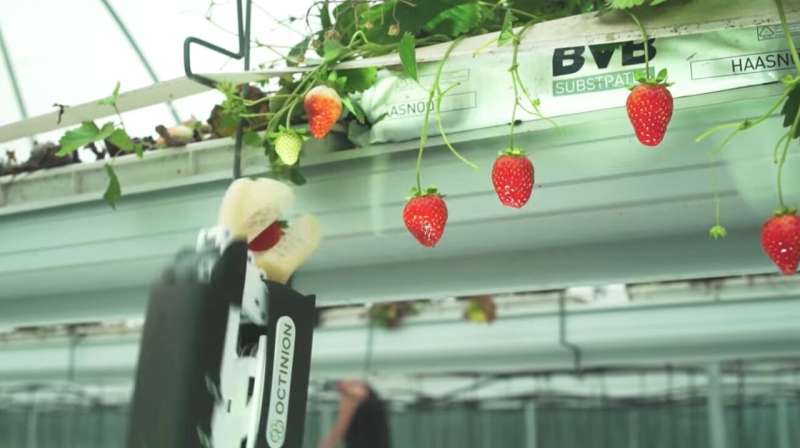July 3, 2019 weblog
Robot uses photonic sensors to pick strawberries in gee-whiz numbers

Robots engineered for picking delicate, soft fruits have not made out very well, for several reasons. Tricky business. Squashed fruit was one drawback and the other was the machine not being smart enough to discern which berry was ripe and which was rotten.
Lucy Hooker, BBC News, said harvesting soft fruit mechanically represented a huge challenge. She said, "each berry needs to be located, even if it's behind a leaf, assessed for ripeness and then harvested and boxed with enormous care to avoid bruising."
Well, the challenge looks a lot less daunting now that Rubion has made its debut, with strawberry-picking features that have impressed. Can the robot discern which fruits are ripe for picking? Check.
Jon Excell, The Engineer named two key features of this robot— smart photonics and a patented soft-touch gripper. The robot can both pick strawberries and sort them by size or weight and pack as it goes along. The strawberries are picked based on ripeness and size. They are packaged in varied categories.
Who is behind Rubion? Design Products & Applications reported on its "photonics" connection, in the name of photonics innovation incubator, which is ACTPHAST 4.0. The latter supported Octinion, a company focused on robotic solutions for agriculture and food. Octinion is a Belgium-based company.
ACTPHAST 4.0 is an SME 'incubator' that helps existing and fledgling businesses with innovation in photonics, and on this occasion it provided the calibration of the RGB camera built into the robot.
"ACTPHAST 4.0, helped considerably to detect the perfect ripe strawberry," Octinion's Dr. Jan Anthonis said.
Meet Rubion, asks the promotional video, and calls it the world's first commercial strawberry picking robot. The robot is said to pose "An answer to your recruiting, training and housing needs."
Human pickers can collect around 50 kilograms in a day but take breaks.
The Scottish Farmer walked readers through the impressive numbers of yield and labor output that would result in using the robots, "promising a 'revolution' in harvesting soft fruit, with a workrate of 11,500 berries in a 16-hour day.
The description said they were bruise-free, every 5 seconds, with the robot's delicate clasping mechanism, and with the ability to deliver between 180 and 360 kilograms every single day.
The robot's launchers cleverly chose the robot's debut to coincide with Wimbledon week's famed berry consumption. That way, they too could run some impressive numbers to build awareness for Rubion.
The makers, said The Scottish Farmer, claimed 14 machines in less than seven days could pick and package "the 34,000 kilos of unblemished strawberries usually consumed by the crowd at the tennis tournament."
The Scottish Farmer said the machine, and all within a 5-second picking cycle, (1) analyzes colors of each fruit and (2) assesses if the fruit is ripe enough for picking via the clasping mechanism.
So, where does that leave human workers? Gordon Davidson quoted Jan Anthonis of the company, who said, "Rotting and unpicked fruit from a lack of human pickers on farms all over the world could soon be tackled with robots."
"You no longer need to worry about finding the right people but you can focus on tomorrow," according to the company web site.
Turn the question over a bit. The people one no longer needs to worry about is all because the focus on tomorrow might be robots. Should those people worry?
Inevitably, a reader comment on one site, The Engineer, asked what would happen to farm labor if robots were to replace them: "The real issue here is what of the unskilled workers or seasonal workers that are trying to earn some extra money? How do you replace these jobs? Just because we can, does not mean we should."
The Belgium-based company have performed trials this summer in partnership with growers in the UK and continental Europe, said Hooker, BBC News
"Photonics" is about generating and harnessing light and other forms of radiant energy whose quantum unit is the photon, according to OP-TEC, The National Center for Optics and Photonics Education. The technology involves "cutting-edge uses of lasers, optics, fiber-optics, and electro-optical devices" in alternate energy, manufacturing, health care, environmental monitoring and other fields.
OP-TEC also said lasers and other light beams were the "preferred carriers" of energy and information for applications such as agriculture, measuring product quality in food and test systems for industry.
More information: octinion.com/
© 2019 Science X Network




















